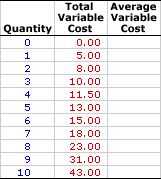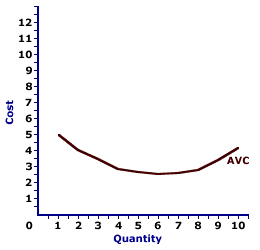Total variable cost per unit of output, found by dividing total variable cost by the quantity of output. When compared with price (per unit revenue), average variable cost (AVC) indicates whether or not a profit-maximizing firm should shut down production in the short run. Average variable cost is one of three average cost concepts important to short-run production analysis. The other two are average total cost and average fixed cost. A related concept is marginal cost.Average variable cost is the total variable cost per unit of output incurred when a firm engages in short-run production. It can be found in two ways. Because average variable cost is total variable cost per unit of output, it can be found by dividing total variable cost by the quantity of output. Alternatively, because total variable cost is the difference between of total cost and total fixed cost, average variable cost can be derived by subtracting average fixed cost from average total cost.
In general, average variable cost decreases with additional production at relatively small quantities of output, then eventually increases with relatively large quantities of output. This pattern is illustrated by a U-shaped average variable cost curve.
Average variable cost, when combined with price, indicates whether or not a firm should shut down production in the short run. If price is greater than average variable cost, then the firm is able to pay all variable cost and a portion of fixed cost. Even though it might be incurring an economic loss, it will lose less by producing that by shutting down production. If, however, price is less than average variable cost, then the firm is better off shutting down production.
Calculating Average Variable Cost
The standard method of calculating average variable cost is to divide total variable cost by the quantity, illustrated by this equation:An alternative specification for average variable cost is found by subtracting average fixed cost from average total cost:
average variable cost = total variable cost
quantity of output
An alternative equation computes total variable cost from average variable cost:
average variable cost = average total cost - average fixed cost
total variable cost = average variable cost x quantity of output
Stuffed Animal Cost
| Average Variable Cost |
|---|
 |
Deriving average variable cost is as simple as dividing the second column of total variable cost values by the first column of output quantity values. The average variable cost of producing 1 Stuffed Amigo is relatively easy--divide $5 by 1 Stuffed Amigo. If the result of this calculation is not readily obvious, click the [One] button.
The average variable cost of two Stuffed Amigos might be a little less obvious, but not much. Click the [Two] button to reveal that the average variable cost is $4, which is $8 divided by 2 Stuffed Amigos. A click of the [Three] shows that the average variable cost of producing 3 Stuffed Amigos is $3.33, $10 divided by 3. The remaining average variable cost values can be displayed by clicking the [Remaining] button.
With all numbers displayed, what interesting insight into average variable cost can be had?
- First, average variable cost is relatively high for the first Stuffed Amigo produced, then declines. However, it reaches a low, then rises with production of the last few Stuffed Amigos. This is the U-shaped pattern noted above.
- Second, average variable cost remains positive, it never reaches a zero value and never turns negative. The only way for negative average variable cost is for negative total variable cost, which makes no theoretical or practical sense.
The Average Variable Cost Curve
| Average Variable Cost Curve |
|---|
 |
The key feature of this average variable cost is the shape. It is U-shaped, meaning it has a negativeslope for small quantities of output, reaches a minimum value, then has a positive slope for larger quantities. This U-shape is indirectly attributable to the law of diminishing marginal returns.
The U-shape of the average variable cost curve is indirectly caused by increasing, then decreasing marginal returns (and the law of diminishing marginal returns). The negatively-sloped portion is attributable to increasing marginal returns and the positively-sloped portion is attributable to decreasing marginal returns (and the law of diminishing marginal returns).